Canary Deployments Using Argo Rollouts and Istio Service-mesh
 George Ezejiofor
George Ezejiofor
Introduction 🚀
🌟 In today’s cloud-native environments, Canary Deployment stands out as a powerful technique for achieving zero-downtime releases. By incrementally rolling out new application versions, canary deployments reduce risk and ensure a seamless user experience. When combined with the advanced rollout strategies of Argo Rollouts and the fine-grained traffic management of Istio Service Mesh, you gain precise control over traffic shifts, enabling smooth transitions between versions. This project also has Automatic Rollback capability for the stable version when canary version deployment goes wrong.
🎯 This guide will show you how to implement Canary Deployment using Argo Rollouts’ intelligent strategies alongside Istio’s traffic-splitting capabilities. You’ll learn how to gradually shift traffic between application versions while maintaining full observability and control. By the end of this guide, you’ll have a robust, production-ready setup that deploys new features seamlessly—without impacting your end users.
✅ Prerequisites 🛠️
To successfully implement Zero Downtime Canary Deployment with Argo-Rollouts and Istio Service-Mesh, ensure you have the following:
🐳 Kubernetes Cluster: A working Kubernetes cluster set up using KUBEADM on a bare-metal setup, with MetalLB configured for LoadBalancer functionality.
💻 kubectl: Install and configure the Kubernetes command-line tool to interact with your cluster.
🧩 Helm: The Kubernetes package manager for simplified application deployment and configuration.
🔒 Cert-Manager (optional): Installed in the cluster for automated TLS certificate management.
🌐 Istio Ingress Controller: Deploy the Istio Ingress Gateway to handle HTTP(S) traffic routing effectively.
📂 Namespace Configuration: Create distinct namespaces or use labels to separate stable and canary deployments for clear isolation.
🌐 Domain Name: Set up a domain (e.g.,
terranetes.co.uk) or a subdomains pointing to your LoadBalancer IP address. You can manage DNS using providers like Cloudflare.📧 Let's Encrypt Account: Ready with a valid email address for certificate issuance to enable HTTPS.
📡 MetalLB: Configured for bare-metal Kubernetes clusters to manage LoadBalancer services.
📈 Kiali: Installed for monitoring Istio's traffic flow and gaining visibility into service dependencies and metrics.
📦 Argo Rollouts: Installed to handle advanced Canary Deployment strategies. Use the following
kubectl create namespace argo-rollouts kubectl apply -n argo-rollouts -f https://github.com/argoproj/argo-rollouts/releases/latest/download/install.yaml📡 Basic Networking Knowledge: Familiarity with Kubernetes networking concepts like Ingress, Services, and LoadBalancer mechanisms.
kubectl get pod -A | grep -E 'argo|istio|metal|cert|monitoring'
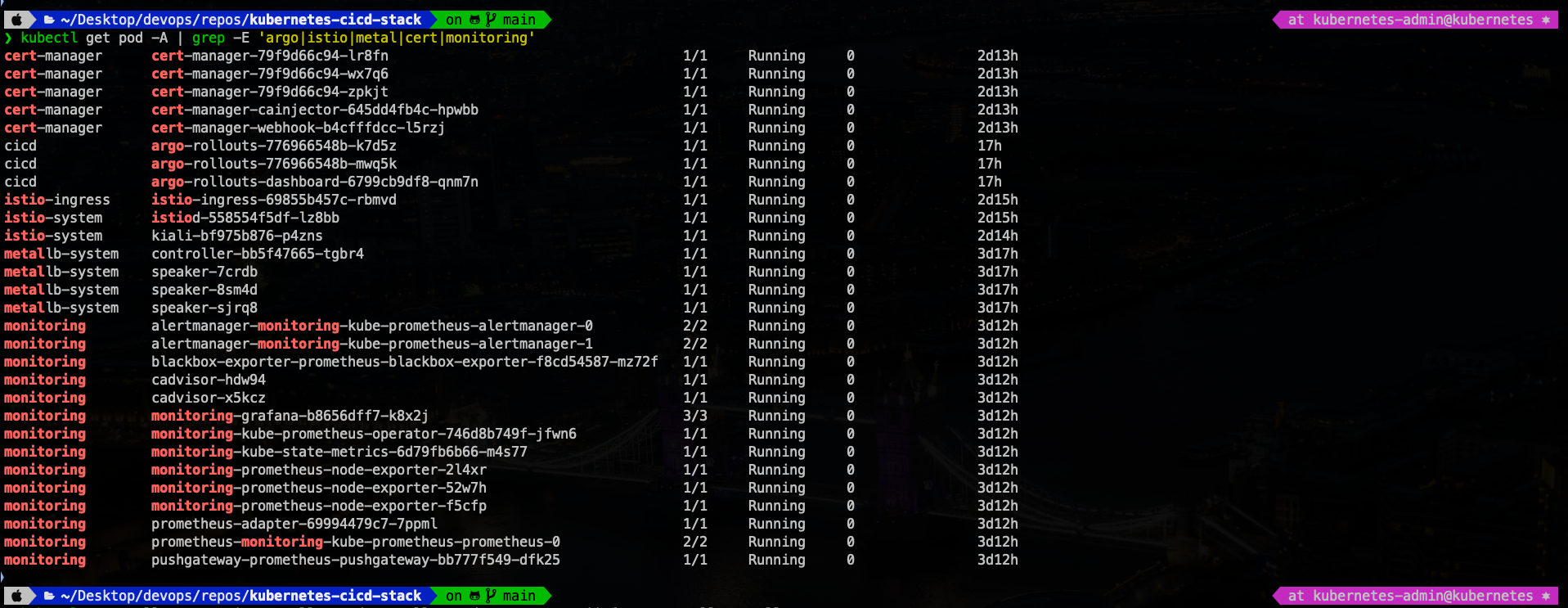
With these prerequisites ready, you're equipped to dive into setting up Canary Deployments! 🚀
Architecture 📈
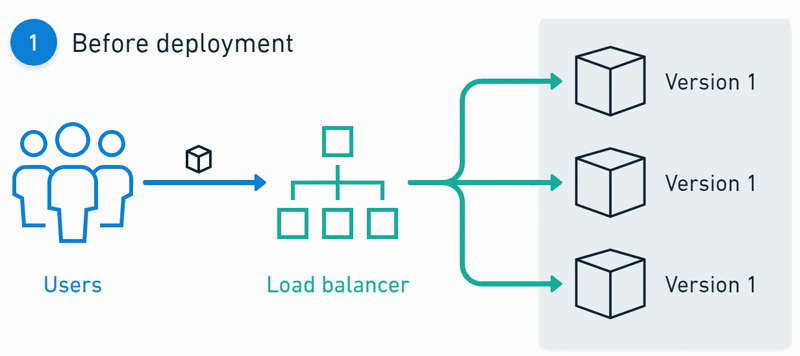
Deployments 🚀
You can get certificate deployment from my BlueGreen deployment article
Argo-rollouts deployment 💻
Deploy Clusterissuer with the same method as Bluegreen Deployment.
Deploy certificate for istio-ingress
cat <<EOF | kubectl apply -f -
apiVersion: cert-manager.io/v1
kind: Certificate
metadata:
name: terranetes-istio-cert
namespace: istio-ingress # Must match the namespace of the Istio ingress gateway
spec:
secretName: terranetes-istio-tls # This is the credentialName in the Gateway resource
duration: 2160h # 90 days
renewBefore: 360h # 15 days
isCA: false
privateKey:
algorithm: RSA
encoding: PKCS1
size: 4096
issuerRef:
name: letsencrypt-dns01-istio
kind: ClusterIssuer
group: cert-manager.io
dnsNames:
- "grafana.terranetes.co.uk"
- "prometheus.terranetes.co.uk"
- "alertmanager.terranetes.co.uk"
- "kiali.terranetes.co.uk"
- "argo-rollout.terranetes.co.uk"
EOFCertificate Issued ✅
Certificate Issued ✅
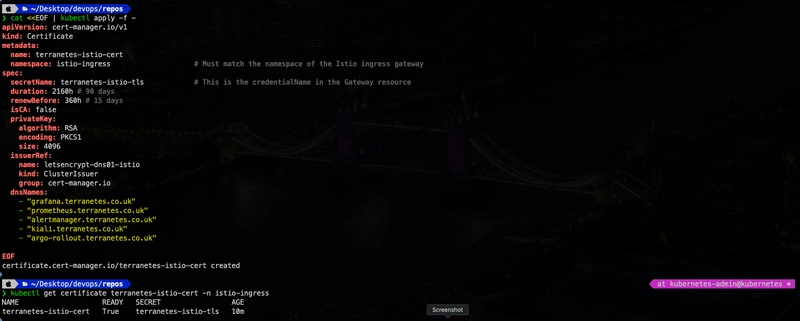
Deploy argo rollout namespace (canary)🏠
cat << EOF | kubectl apply -f -
apiVersion: v1
kind: Namespace
metadata:
name: canary
labels:
istio-injection: enabled
EOF
Deploy argo rollout Gateway
cat << EOF | kubectl apply -f -
apiVersion: networking.istio.io/v1alpha3
kind: Gateway
metadata:
name: terranates-app-gateway
namespace: istio-ingress
spec:
selector:
istio: ingress # use istio default controller
servers:
- port:
number: 80
name: http
protocol: HTTP
hosts:
- "*"
tls:
httpsRedirect: true # Redirect HTTP to HTTPS
- port:
number: 443
name: https
protocol: HTTPS
tls:
mode: SIMPLE
credentialName: terranetes-istio-tls # Reference the TLS secret
hosts:
- "argo-rollout.terranetes.co.uk"
EOF
Deploy argo rollout Services
cat << EOF | kubectl apply -f -
apiVersion: v1
kind: Service
metadata:
name: terranates-app-canary
namespace: canary
labels:
app: terranates-app # Add this label
spec:
ports:
- port: 80
targetPort: http
protocol: TCP
name: http
selector:
app: terranates-app
# This selector will be updated with the pod-template-hash of the canary ReplicaSet. e.g.:
# rollouts-pod-template-hash: 7bf84f9696
---
apiVersion: v1
kind: Service
metadata:
name: terranates-app-stable
namespace: canary
labels:
app: terranates-app # Add this label
spec:
ports:
- port: 80
targetPort: http
protocol: TCP
name: http
selector:
app: terranates-app
# This selector will be updated with the pod-template-hash of the stable ReplicaSet. e.g.:
# rollouts-pod-template-hash: 789746c88d
EOF
Deploy argo rollout VirtualServices
cat << EOF | kubectl apply -f -
apiVersion: networking.istio.io/v1alpha3
kind: VirtualService
metadata:
name: terranates-app-vs1
namespace: canary
spec:
gateways:
- istio-ingress/terranates-app-gateway
hosts:
- "argo-rollout.terranetes.co.uk"
http:
- name: route-one
route:
- destination:
host: terranates-app-stable
port:
number: 80
weight: 100
- destination:
host: terranates-app-canary
port:
number: 80
weight: 0
EOF
Deploy argo rollout Terranetes webapp
cat << EOF | kubectl apply -f -
apiVersion: argoproj.io/v1alpha1
kind: Rollout
metadata:
name: terranates-app
namespace: canary
spec:
replicas: 10
strategy:
canary:
canaryService: terranates-app-canary
stableService: terranates-app-stable
analysis:
startingStep: 2
templates:
- templateName: istio-success-rate
args:
- name: service
value: terranates-app-canary # ✅ Canary service name
- name: namespace
valueFrom:
fieldRef:
fieldPath: metadata.namespace
trafficRouting:
istio:
virtualServices:
- name: terranates-app-vs1
routes:
- route-one
steps:
- setWeight: 10
- pause: {}
- setWeight: 20
- pause: {duration: 30s}
- setWeight: 30
- pause: {duration: 30s}
- setWeight: 40
- pause: {duration: 30s}
- setWeight: 50
- pause: {duration: 30s}
- setWeight: 60
- pause: {duration: 30s}
- setWeight: 70
- pause: {duration: 30s}
- setWeight: 80
- pause: {duration: 30s}
- setWeight: 90
- pause: {duration: 30s}
- setWeight: 100
selector:
matchLabels:
app: terranates-app
template:
metadata:
labels:
app: terranates-app
spec:
containers:
- name: terranates-app
image: georgeezejiofor/argo-rollout:yellow
ports:
- name: http
containerPort: 8080
EOF
Deploy argo rollout AnalysisTemplate
cat << EOF | kubectl apply -f -
apiVersion: argoproj.io/v1alpha1
kind: AnalysisTemplate
metadata:
name: istio-success-rate
namespace: canary
spec:
args:
- name: service
- name: namespace
metrics:
- name: success-rate
interval: 10s
successCondition: result[0] < 0.2 or result[1] < 10 # ✅ Handle low traffic
failureCondition: result[0] >= 0.2
failureLimit: 3
provider:
prometheus:
address: http://monitoring-kube-prometheus-prometheus.monitoring.svc.cluster.local:9090
query: >+
(
sum(irate(istio_requests_total{
reporter="source",
destination_service=~"{{args.service}}.{{args.namespace}}.svc.cluster.local",
response_code!~"2.*"}[2m])
)
/
sum(irate(istio_requests_total{
reporter="source",
destination_service=~"{{args.service}}.{{args.namespace}}.svc.cluster.local"}[2m])
)
)
# Add total requests as second metric
,
sum(irate(istio_requests_total{
reporter="source",
destination_service=~"{{args.service}}.{{args.namespace}}.svc.cluster.local"}[2m])
)
EOF
Validate deployments in “canary” namespace
kubectl get all -n canary
# All these should show resources after successful deployment
kubectl get svc -n canary --show-labels
kubectl get rollout -n canary
kubectl get gateway -n canary
kubectl get virtualservice -n canary
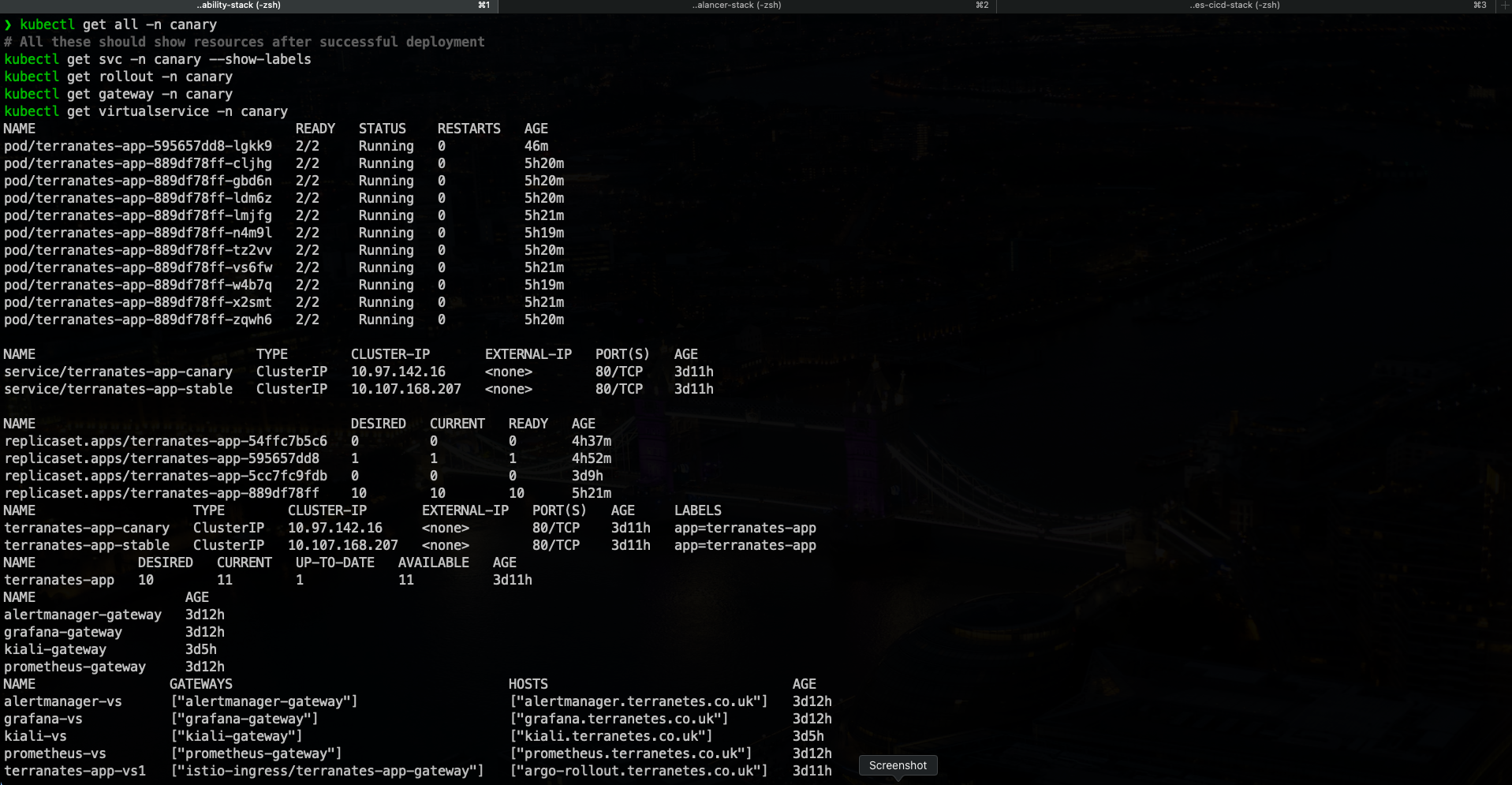
Generate Traffic (Essential!): using hey command for macOS users
hey -z 5m -q 10 https://argo-rollout.terranetes.co.uk
Set new Green image for argo rollout
kubectl argo rollouts set image terranates-app terranates-app=georgeezejiofor/argo-rollout:green -n canary
Set new Red image for argo rollout
kubectl argo rollouts set image terranates-app terranates-app=georgeezejiofor/argo-rollout:red -n canary
Set new Blue image for argo rollout
kubectl argo rollouts set image terranates-app terranates-app=georgeezejiofor/argo-rollout:blue -n canary
Set new Yellow image for argo rollout
kubectl argo rollouts set image terranates-app terranates-app=georgeezejiofor/argo-rollout:yellow -n canary
Set new Purple image for argo rollout
kubectl argo rollouts set image terranates-app terranates-app=georgeezejiofor/argo-rollout:purple -n canary
Watch argo-rollouts
kubectl argo rollouts get rollout terranates-app -n canary -w
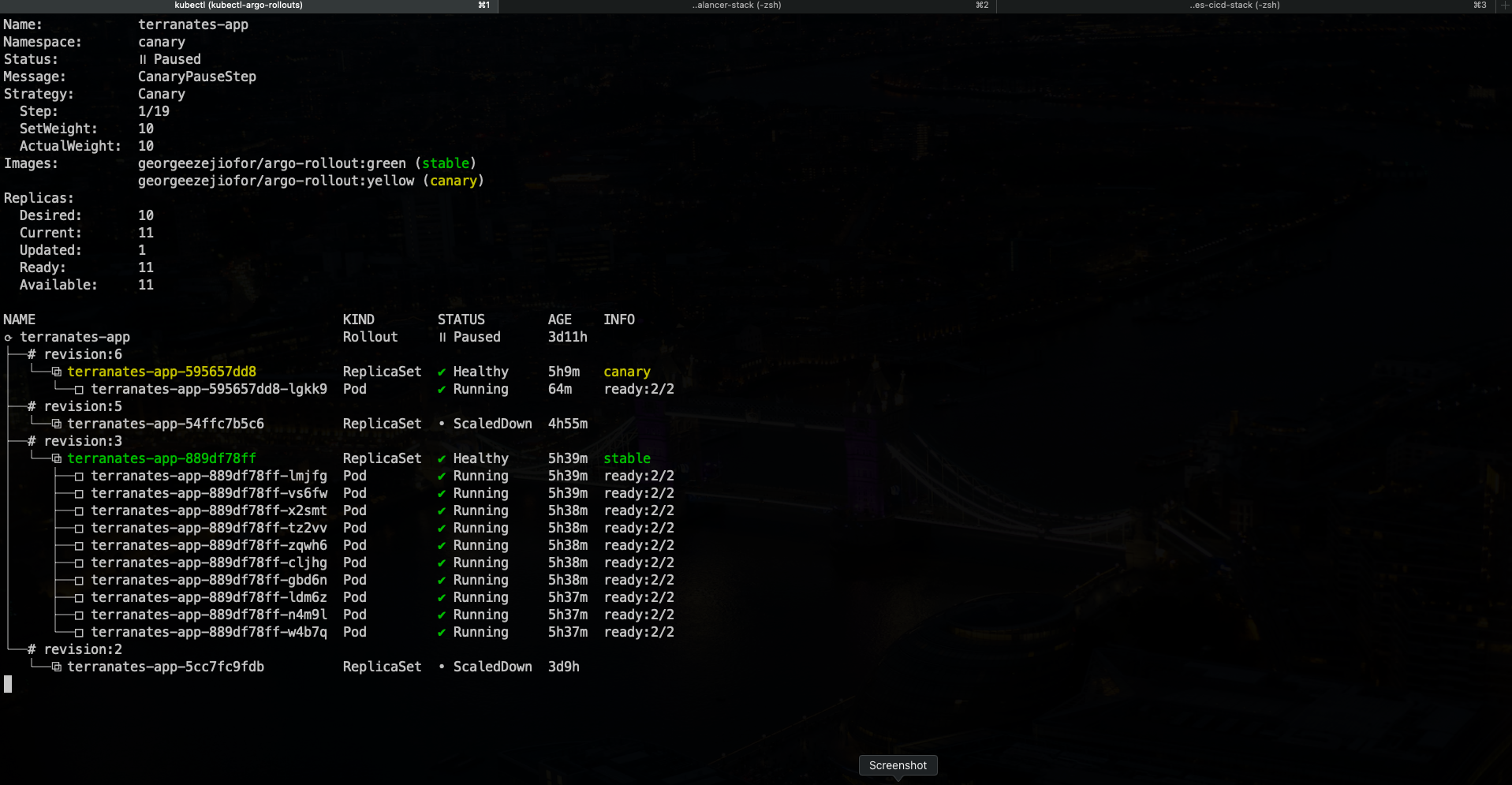
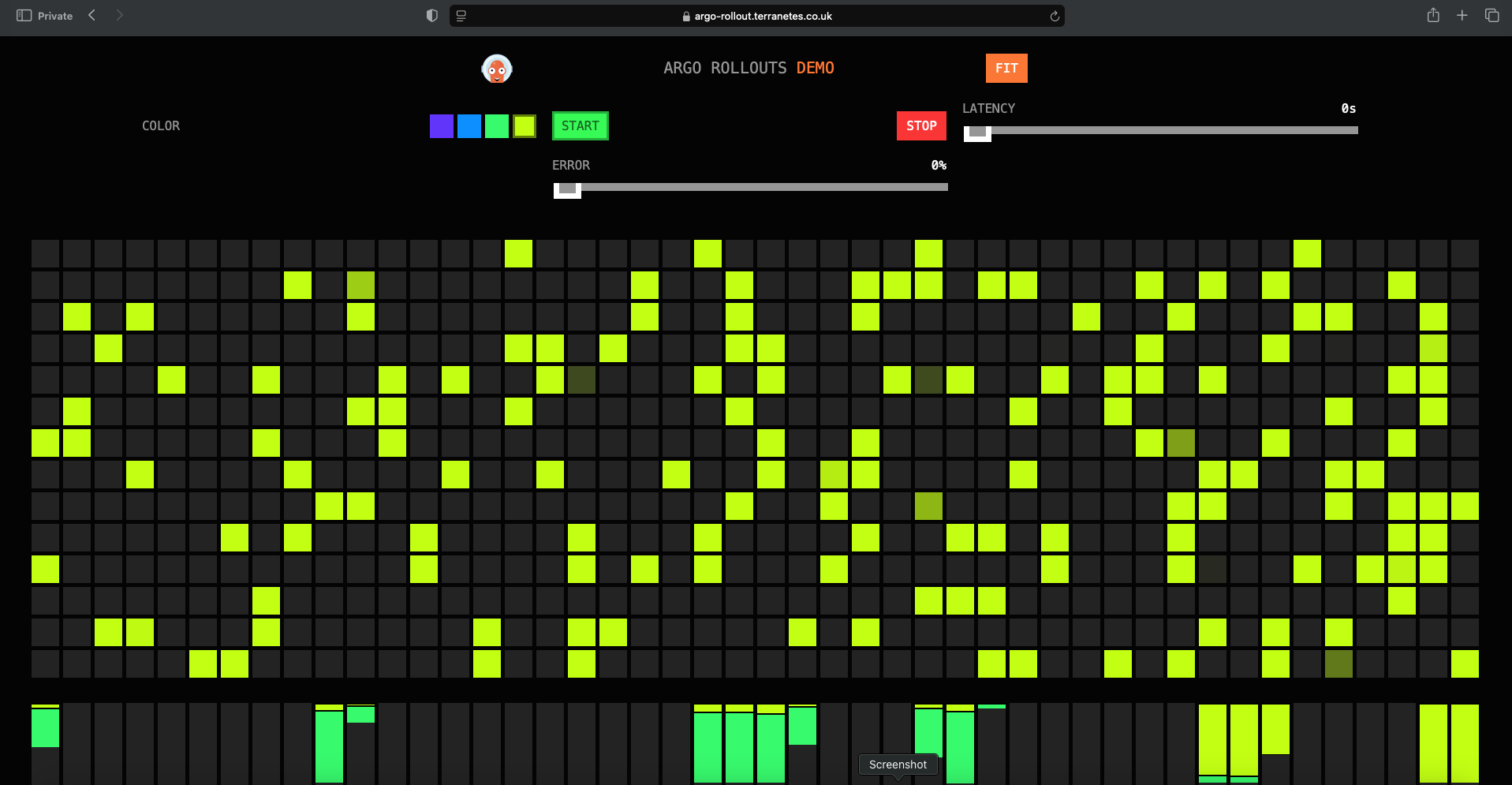
Visual Testing for Rollouts and Automatic Rollback 😊
Conclusion 🎉
Congratulations! You’ve just unlocked the power of zero-downtime deployments with Argo Rollouts and Istio! 🚀 By combining Argo Rollouts’ intelligent canary strategies with Istio’s granular traffic management, you’ve built a robust system that:
Reduces Risk 😌: Gradually shift traffic to new versions while monitoring real-time metrics.
Ensures Smooth User Experience 🌟: No downtime, no disruptions—just seamless updates.
Automates Rollbacks 🛡️: Detect issues early and revert to stable versions effortlessly.
Optimizes Traffic Control 🎛️: Istio’s dynamic routing ensures precise traffic splitting.
With this setup, you’re not just deploying code—you’re delivering confidence. 💪 Whether you’re rolling out mission-critical features or experimenting with new updates, this integration empowers you to innovate fearlessly.
Next Project: Observability Stacks 📈
Now that you've mastered canary deployments, it's time to build a powerful observability stack for deeper insights into your applications! 🚀 In this next project, we'll explore tools that provide real-time monitoring, centralized logging, and distributed tracing to help you maintain a reliable and performant system.
Observability Tools We’ll Cover 🛠️
Dive into building a powerful observability stack for deeper insights! We'll explore tools like Prometheus, Grafana, Loki, Jaeger, OpenTelemetry, Kiali, and the promtail for real-time monitoring, logging, and tracing. 🛠️
Stay tuned for hands-on implementations and best practices! 🎯This stack will help you monitor, troubleshoot, and optimize your applications with full visibility into system behavior.
Stay tuned as we explore hands-on implementations and best practices! 🎯
Follow me on Linkedin George Ezejiofor to stay updated on cloud-native observability insights! 😊
Happy deploying! 🚀🎉
Subscribe to my newsletter
Read articles from George Ezejiofor directly inside your inbox. Subscribe to the newsletter, and don't miss out.
Written by

George Ezejiofor
George Ezejiofor
As a Senior DevSecOps Engineer, I’m dedicated to building secure, resilient, and scalable cloud-native infrastructures tailored for modern applications. With a strong focus on microservices architecture, I design solutions that empower development teams to deliver and scale applications swiftly and securely. I’m skilled in breaking down monolithic systems into agile, containerised microservices that are easy to deploy, manage, and monitor. Leveraging a suite of DevOps and DevSecOps tools—including Kubernetes, Docker, Helm, Terraform, and Jenkins—I implement CI/CD pipelines that support seamless deployments and automated testing. My expertise extends to security tools and practices that integrate vulnerability scanning, automated policy enforcement, and compliance checks directly into the SDLC, ensuring that security is built into every stage of the development process. Proficient in multi-cloud environments like AWS, Azure, and GCP, I work with tools such as Prometheus, Grafana, and ELK Stack to provide robust monitoring and logging for observability. I prioritise automation, using Ansible, GitOps workflows with ArgoCD, and IaC to streamline operations, enhance collaboration, and reduce human error. Beyond my technical work, I’m passionate about sharing knowledge through blogging, community engagement, and mentoring. I aim to help organisations realize the full potential of DevSecOps—delivering faster, more secure applications while cultivating a culture of continuous improvement and security awareness.